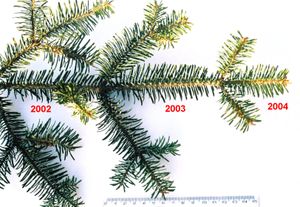Evergreen
In botany, an evergreen plant is a plant having leaves all year round. This contrasts with deciduous plants, which completely lose their foliage for part of the year. more...
Leaf persistence in evergreen plants may vary from a few months (with new leaves constantly being grown and old ones shed), to several decades (over thirty years in Great Basin Bristlecone Pine Pinus longaeva ).
One additional special case exists in Welwitschia, an African gymnosperm plant which produces only two leaves, which grow continuously throughout the plant's life but gradually wear away at the apex, giving about 20–40 years' persistence of leaf tissue.
There are many different types of evergreens, both trees and shrubs, including most species of: conifers (e.g. white/scots/jack pine, red cedar, blue spruce), holly, hemlock, 'ancient' gymnosperms like cycads, rainforest trees and Eucalypts.
Reasons for being evergreen or deciduous
Deciduous trees shed their leaves usually as an adaptation to a cold season or a dry season. Most tropical rainforest plants are evergreens, replacing their leaves gradually throughout the year as the leaves age and fall, whereas species growing in seasonally arid climates may be either evergreen or deciduous. Most warm temperate climate plants are also evergreen. In cool temperate climates, fewer plants are evergreen, with a predominance of conifers, as few evergreen broadleaf plants can tolerate severe cold below about -30 °C.
In areas where there is a reason for being deciduous (e.g. a cold season or dry season), being evergreen is usually an adaptation to low nutrient levels. Deciduous trees lose nutrients whenever they lose their leaves, and they must replenish these nutrients from the soil to build new leaves. When few nutrients are available, evergreen plants have an advantage. In warmer areas, species such as some pines and cypresses grow on poor soils and disturbed ground. In Rhododendron, a genus with many broadleaf evergreens, several species grow in mature forests but are usually found on highly acidic soil where the nutrients are less available to plants. In taiga or boreal forests, it is too cold for the organic matter in the soil to decay rapidly, so the nutrients in the soil are less easily available to plants, thus favouring evergreens.
In temperate climates, evergreens can reinforce their own survival; evergreen leaf and needle litter has a higher carbon-nitrogen ratio than deciduous leaf litter, contributing to a higher soil acidity and lower soil nitrogen content. These conditions favour the growth of more evergreens and make it more difficult for deciduous plants to persist. In addition, the shelter provided by existing evergreen plants can make it easier for other evergreen plants to survive cold and/or drought.
Read more at Wikipedia.org


